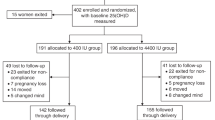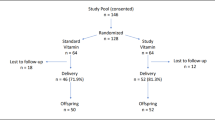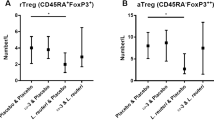Abstract
Vitamin D has been suggested to affect the balance between T helper (Th1) and (Th2) type cytokines by favouring Th2 domination. We investigated the association between infant vitamin D supplementation and later pre-eclampsia, a disorder suggested to be dominated by Th1 response. We used data on 2969 women born in the Northern Finland Birth Cohort 1966 of whom 68 (2.3%) had pre-eclampsia in their first pregnancy. Risk of pre-eclampsia was halved (OR 0.49, 95% confidence interval (CI) 0.26–0.92) in participants who had received vitamin D supplementation regularly during the first year of life and this association was not affected by adjustment for own birth order, birth weight, gestational age, social class in 1966 and hospitalizations or pregnancy-induced hypertension of their mothers. Together with earlier observations on a reduced risk of type 1 diabetes after vitamin D supplementation, these data suggest that vitamin D intake in infancy may affect long-term programming of the immune response pattern.
This is a preview of subscription content, access via your institution
Access options
Subscribe to this journal
Receive 12 print issues and online access
$259.00 per year
only $21.58 per issue
Buy this article
- Purchase on Springer Link
- Instant access to full article PDF
Prices may be subject to local taxes which are calculated during checkout
Similar content being viewed by others
References
Brown MA, Lindheimer MD, de Swiet M, Van Assche A, Moutquin JM (2001). The classification and diagnosis of the hypertensive disorders of pregnancy: statement from the international society for the study of hypertension in Pregnancy (ISSHP). Hypertens Pregnancy 20, IX–XIV.
Gissler M, Teperi J, Hemminki E, Meriläinen J (1995). Data quality after restructuring a nationwide medical birth registry. Scand J Soc Med 23, 75–80.
Hayes CE, Nashold FE, Spach KM, Pedersen LB (2003). The immunological functions of the vitamin D endocrine system. Cell Mol Biol (Noisy -le-grand) 49, 277–300.
Hofmeyr GJ, Atallah AN, Duley L (2003). Calcium supplementation during pregnancy for preventing hypertensive disorder and related problems (Cochrane Review). The Cochrane Library [Issue 4]. UK, John Wiley & Sons, Ltd; Chichester.
Hyppönen E (2005). Vitamin D for the prevention of preeclampsia? A hypothesis. Nutr Rev 63, 225–232.
Hyppönen E, Läärä E, Reunanen A, Järvelin M, Virtanen SM (2001). Intake of vitamin D and risk of type 1 diabetes: a birth-cohort study. Lancet 358, 1500–1503.
Hyppönen E, Sovio U, Wjst M, Patel S, Pekkanen J, Hartikainen AL et al. (2004). Infant vitamin D supplementation and allergic conditions in adulthood – Northern Finland Birth Cohort 1966. Ann NY Acad Sci 1037, 84–95.
Mathieu C, Adorini L (2002). The coming of age of 1,25-dihydroxyvitamin D (3) analogs as immunomodulatory agents. Trends Mol Med 8, 174–179.
Pouta A, Hartikainen AL, Sovio U, Gissler M, Laitinen J, McCarthy MI et al. (2004). Manifestations of metabolic syndrome after hypertensive pregnancy. Hypertension 43, 825–831.
Prentice AM, Cole TJ, Moore SE, Collinson AC (1999). Programming of the adult immune system. In: O'Brien PMS, Wheeler T, Barker DJP (eds). Fetal Programming. Influences on Development and Disease in Later Life vol 34 RCOG Press; London. 399–413 pp. 399–413.
Rantakallio P (1969). Groups at risk in low birth weight infants and perinatal mortality. Acta Padiatr Scand (Suppl) 193, 1–71.
Roep BO (2003). The role of T-cells in the pathogenesis of type 1 diabetes: from cause to cure. Diabetologia 46, 305–321.
Romagnani S (2004). Immunologic influences on allergy and the TH1/TH2 balance. J Allergy Clin Immunol 113, 395–400.
Royston P (2004). Multiple imputation of missing values. Stata J 4, 227–241.
Saito S, Sakai M (2003). Th1/Th2 balance in preeclampsia. J Reprod Immunol 59, 161–173.
Sibai B, Dekker G, Kupferminc M (2005). Pre-eclampsia. Lancet 365, 785–799.
Spencer SJ, Martin S, Mouihate A, Pittman QJ (2006). Early-life immune challenge: defining a critical window for effects on adult responses to immune challenge. Neuropsychopharmacology.
Spilianakis CG, Lee GR, Flavell RA (2005). Twisting the Th1/Th2 immune response via the retinoid X receptor: lessons from a genetic approach. Eur J Immunol 35, 3400–3404.
The EURODIAB Substudy 2 Study Group (1999). Vitamin D supplement in early childhood and risk for Type I (insulin-dependent) diabetes mellitus. Diabetologia 42, 51–54.
Wharton B, Bishop N (2003). Rickets. Lancet 362, 1389–1400.
Acknowledgements
This work was supported by grants from the Academy of Finland, the Ministry of Social and Health Affairs, Oulu University Hospital, and the BUPA Foundation. EH is Department of Health (UK) Public Health Career Scientist. Research at the Institute of Child Health and Great Ormond Street Hospital for Children NHS Trust benefits from R&D funding received from the NHS Executive.
Author information
Authors and Affiliations
Corresponding author
Additional information
Guarantor: E Hyppönen.
Contributors: EH had the study idea, carried out the analyses and wrote the paper. AP reviewed the hospital records and certified the diagnoses. Thirty-one year survey was designed by AP, ALH and MRJ. US managed the data and commented statistical methods. All authors participated in the evaluation of the results and contributed to the final version of the paper.
Rights and permissions
About this article
Cite this article
Hyppönen, E., Hartikainen, AL., Sovio, U. et al. Does vitamin D supplementation in infancy reduce the risk of pre-eclampsia?. Eur J Clin Nutr 61, 1136–1139 (2007). https://doi.org/10.1038/sj.ejcn.1602625
Received:
Revised:
Accepted:
Published:
Issue Date:
DOI: https://doi.org/10.1038/sj.ejcn.1602625
Keywords
This article is cited by
-
Potential impact of maternal vitamin D status on obstetric well-being
Journal of Endocrinological Investigation (2016)
-
Common misconceptions about vitamin D—implications for clinicians
Nature Reviews Endocrinology (2013)
-
Vitamin D Deficiency in Pregnancy and Lactation and Health Consequences
Clinical Reviews in Bone and Mineral Metabolism (2009)
-
Vitamin D deficiency in children and adolescents: Epidemiology, impact and treatment
Reviews in Endocrine and Metabolic Disorders (2008)



